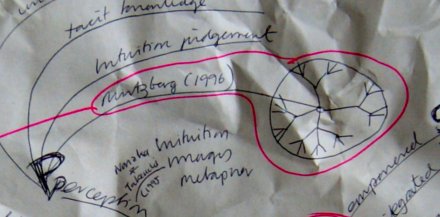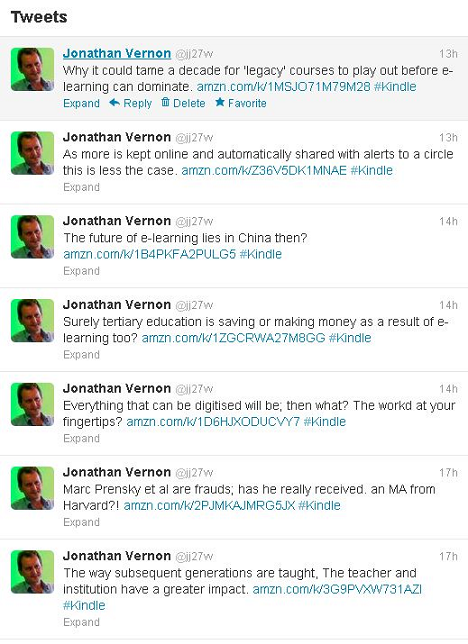
Fig. 1. Digital Scholarship (Vernon, 2011)
I?ve drawn on ideas from the Masters in Open & Distance Education (MAODE) that I have been studying with The OU since February 2010. Also ?The Digital Scholar? by Martin Weller and ?Preparing for blended e-learning? by Chris Pegler.
I come to the conclusion that learning, or rather teaching as a form of education is moving towards greater fluidity and liveliness in the relationship between the academic (author/lecturer) and the student.
The model education should look to is one developed in business, something I stumble upon studying OU MBA Module ?Creativity, Innovation & Change?
Drawing on a business model, the development of a more organic structure that is less hierarchical, as envisaged by Henry Mintzberg (1994), seems appropriate; it complements what authors such as John Seely Brown say about ?learning from the periphery? too. Mintzberg talks of an adhocracy, doodle here when I was making hand-drawn mind-maps during revision for an end of module exam (EMA).
Adhocracy

Characteristics of an adhocracy (Waterman, 1990; Mintzberg, 1994; Travica, 1999):
- highly organic structure
- little formalization of behavior
- job specialization based on formal training
- a tendency to group the specialists in functional units for housekeeping purposes but to deploy them in small, market-based project teams to do their work
- a reliance on liaison devices to encourage mutual adjustment within and between these teams
- low standardization of procedures
- roles not clearly defined
- ?selective decentralization
- ?work organization rests on specialized teams
- power-shifts to specialized teams
- horizontal job specialization
- high cost of communication (dramatically reduced in the networked age)
- culture based on non-bureaucratic work
One could also draw on a simpler organic structure developed, again in the MBA arena, by Charles Handy.
Handy?s Shamrock (1989)
The advantage of a flexible organisation is that it can react quickly to a change in its external environment.
Since the 1990s, firms have examined their value chain and tried to reduce their workforce to a multi-skilled core, which is concerned with the creation or delivery of a product or service. All other supporting, non-central functions are outsourced wherever possible to the periphery.
Charles Handy suggested, however, that organisations do not consist of just the Core and the Periphery, since the periphery can be subdivided.
He calls this a shamrock organisation:
- The first leaf of the shamrock represents the multi-skilled core of professional technicians and managers, essential to the continuity of the business
- The second leaf Handy calls the contractual fringe, because non central activities are contracted out to firms specialising in activities such as marketing, computing, communications and research
- The third leaf consists of a flexible workforce made up of part-time, temporary and seasonal workers.
However, the model I constantly turn to is the Activity System of Engestrom (via Vygotsky).
which also has its organic expression, not dissimilar to the Mintzberg concentric organisational plan and John Seely Brown?s ideas of learning from the periphery:
A Mycorrihizae fungi
In the spirit of digital scholarship I?ve been experimenting with using Twitter to share thoughts on more than one book as I read them, highlighting a point and adding a Tweet. The feedback has been interesting, as has been the influx of new Twitter followers, invariable all with an academic or commercial interest in e-learning.

So come and join the feed, though from time to time you will receive tips on swim teaching best practice (how to fix a screw kick in breaststroke and some such) or as likely thoughts on life in the trenches as a machine gunner as we approach the centenary of the First World War.

Fig. 2. Expanding ideas with multiple e-tivities and assets online. Vernon (2010)
I?d like to see this offered as an APP or Tool so that digital assets (stuff) or ?E-tivities? (Salmon, 2002) are automatically aggregated as a fluid, initial offer. In other words, assets are seen as a way of catalysing a process of exploration.
REFERENCE
Brown, J.S., Collins.A., Duguid, P., (1989) Situated Cognition and the Culture of Learning. Educational Researcher, Vol. 18, No. 1 (Jan. ? Feb., 1989), pp. 32-42 American Educational Research Association Stable URL: http://www.jstor.org/stable/1176008 . Accessed: 05/03/2011 13:10
Engestr?m (2001) article,?Expansive learning at work: toward an activity theoretical reconceptualisation
Handy, C (1989) The Age of Unreason
Mintzberg, H (1994), The Rise and Fall of Strategic Planning: Reconceiving the Roles for Planning, Plans, Planners, Free Press, pp. 458, ISBN 0-02-921605-2
Salmon, G (2002) E-tivities. The key to online learning
Travica, B (1999) New Organizational Designs: Information Aspects, Ablex/Greenwood, ISBN 1-56750-403-5, Google Print, p.7
Vernon, J.F. (2010-2012) Open University Student Blog
Vernon, J.F. (2011) Mindmaps, screen grabs and other e-learning ephemera
Vygotsky, L.S. (1978)?Mind in Society: The Development of Higher Psychological Processes, Cambridge, MA, Harvard University Press.
Waterman, R. H. (1990). Adhocracy: The power to change. The Larger agenda series. Knoxville, Tenn: Whittle Direct Books.
Like this:
One blogger likes this post.
james randi wargames blake griffin dunk florida primary full force odd fellows eli whitney
No comments:
Post a Comment
Note: Only a member of this blog may post a comment.